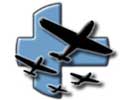Galena Pavlovna Brok-Bel'tsova,
Ekaterina Polunina
And
Anna Kiralina -
Russian
Women
War-pilots
Quick index: [
Galena Pavlovna Brok-Bel'tsova, Ekaterina Polunina and Anna Kiralina - Russian women war-pilots |
Credits]
Gordon Permann wrote the following report about three Soviet Air Force woman wartime combat pilots, when they visited US and gave a lecture telling about their experiences. Gordon also sent the related photographs from their visit.
Galena Pavlovna Brok-Bel'tsova, Ekaterina Polunina and Anna Kiralina - Russian women war-pilots
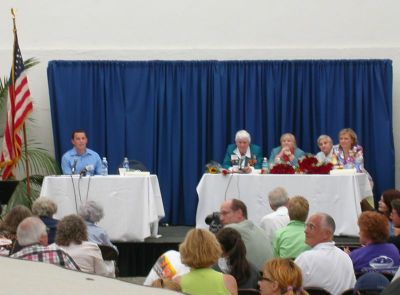 1230, 22 June 2005, three former members of the Soviet Air Force came to the
weekly meeting of the "Old Bold Pilots Association", held in Oceanside.
Alongside P-51 pilot and aviator Ray Toliver, fifty other airmen and their wives,
these three veterans spoke to a pin-drop quiet audience about their wartime
careers with the Red Air Force. What makes these vets different is that they
are all women.
1230, 22 June 2005, three former members of the Soviet Air Force came to the
weekly meeting of the "Old Bold Pilots Association", held in Oceanside.
Alongside P-51 pilot and aviator Ray Toliver, fifty other airmen and their wives,
these three veterans spoke to a pin-drop quiet audience about their wartime
careers with the Red Air Force. What makes these vets different is that they
are all women.
Since their arrival in San Diego, these impressive ladies did the
usual tourism stops, including an up-close encounter with a giant sea lion at
Sea World. On a less well beaten track, they were invited to tour MCAS
Miramar, with visit to Marine helicopter units where there are female Marine
pilots on duty. These profession aviators extended them a warm welcome and the
Soviet veterans were gracious and emotionally moved by their treatment.
Veterans of ground attack and fighter units, the three women
served in diverse roles, including armorer, engine mechanic, and as a combat
aircrew. For them, the war is as clear as yesterday - they recall the horrors, the
momentary joys and the quirky things that kept life interesting. Mail
delivery during the buildup to the massive land battle at Kursk, for instance, took
a month to travel from one unit to the next, only 100 meters away!
Galena Pavlovna Brok-Bel’tsova, born in Moscow. Dive Bomber
regiment. All of her classmates tried to quit school on the date of the invasion
in order to fight the invader.
"In the HQ, everyone was asked, "What can you do to help?" "
Nothing, we have no training." The army sent them away and said, wait for us to
call you. Two of the ladies had identical experiences in this regard.
Later, they offered us training as medical assistants."
During the medical testing, the most fit, best qualified were
sent to the front. Galena was sent to be a medical liaison for the Moscow air
defense forces during the intense combat that nearly gutted the city.
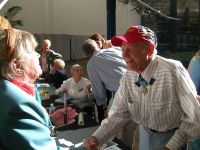 She began her flying career as a Su-2 crewman but the aircraft
was hopelessly obsolete and slaughtered in combat. In a role unique to the
Soviet Air Force, Galena was selected as a "pilot watcher", although the idea of
a pilot defecting was considered unfathomable. In actual practice, the "pilot
watchers" served as combination navigator and observer/gunner. Within a
year, she was posted to first to heavy bombers, and later the slim PE-2 medium "
fast bomber" for training. She was eager to get into combat and was posted
directly to a front line unit as a replacement.
She began her flying career as a Su-2 crewman but the aircraft
was hopelessly obsolete and slaughtered in combat. In a role unique to the
Soviet Air Force, Galena was selected as a "pilot watcher", although the idea of
a pilot defecting was considered unfathomable. In actual practice, the "pilot
watchers" served as combination navigator and observer/gunner. Within a
year, she was posted to first to heavy bombers, and later the slim PE-2 medium "
fast bomber" for training. She was eager to get into combat and was posted
directly to a front line unit as a replacement.
When asked if there units were co-ed, Galena replied that they
started under the command of pre-war aviation hero, Marina Raskova, who created
the three female air regiments. As far as the women in these units, Raskova
was the ‘rule’ or the example to be emulated, and all three of these women
believe that they were drawn into aviation because of this aviation pioneer’s
charismatic personality.
Primarily, these were all-female units, although there were a few
rare exceptions (usually to replace a critical loss at a moment when there
was no immediately suitable female replacement). 100% of the pilots, gunners,
and bombardiers were women.
Matter of factly, she stated, "We suffered 50% casualties among
our flight crews." As losses occurred, some few men served in their units and
after Raskova crashed into a river and perished on an operational flight, a
male commander took over for the duration of the war.
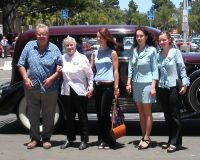 Ekaterina Polunina was a Yakovlev fighter mechanic assigned to
the 586th Regiment. When the war started, many young people had already begun
to enter aviation and mechanical fields, even though for the most part the
people in the countryside stayed involved in farming. Before the war, Ekaterina
maintained racing motorbikes and for her, the thundering engine on a fighter
aircraft was quite intimidating. When Raskova went from school to school to
recruit highly qualified candidates, the young motorcycle mechanic decided that
aviation would be her career. Ekaterina was selected due to her mental
sharpness and mechanical aptitude, which is still apparent today.
Ekaterina Polunina was a Yakovlev fighter mechanic assigned to
the 586th Regiment. When the war started, many young people had already begun
to enter aviation and mechanical fields, even though for the most part the
people in the countryside stayed involved in farming. Before the war, Ekaterina
maintained racing motorbikes and for her, the thundering engine on a fighter
aircraft was quite intimidating. When Raskova went from school to school to
recruit highly qualified candidates, the young motorcycle mechanic decided that
aviation would be her career. Ekaterina was selected due to her mental
sharpness and mechanical aptitude, which is still apparent today.
She was the personal mechanic of the woman who became the first
Soviet female fighter pilot to score an aerial victory over a Fascist warplane.
Ms. Polunina shared the story with obvious pride, knowing her role made that
success directly possible.
"The responsibility for maintaining a fighter was almost the same
as for the pilot to master the aircraft - the pilot absolutely depended on
the mechanic and we were equal partners. We shared in everything, the good and
the bad."
"There is a recent book called "Girlies, Friends, and Pilots;
the 125th Fighter Regiment" [or something close? - G] and since the war, I have
devoted my life to recording our unit’s history."
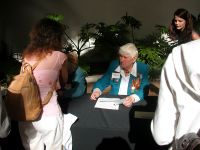 Anna Kiralina, served as an armament technician in a dive bomber
regiment. Originally from Smolensk, she could not get an education and
considered herself quite an "average girl". She worked in textiles until the war,
but like everyone else, she knew "the air smelled of gunpowder" from
1937-1940.
Anna Kiralina, served as an armament technician in a dive bomber
regiment. Originally from Smolensk, she could not get an education and
considered herself quite an "average girl". She worked in textiles until the war,
but like everyone else, she knew "the air smelled of gunpowder" from
1937-1940.
Masses of young people volunteered immediately after the
invasion, but Anna and many others were told to wait until they were called to report.
Later in 1941, she was called up and the Red Army was looking for robust,
fit and mentally sharp people to work in aviation. She was selected to become
an armament technician despite her small frame, and threw herself into her
appointed tasks.
"Life in front line aviation units was grim. Many times, the
planes were shot down right in front of us, burning fiercely. There was
nothing that could be done for them. They were not even recognizable. Pilots were
ordered to wear their medals to make it easier to identify their remains -
some of the medals had presentation numbers, or else they could tell using
records, of which pilots had which medals and so on. Often, combat occurred
directly over or near our airfields, so we could see the losing pilot fall on fire,
crashing into the ground and burning."
Anna’s responsibility was to load 1000 kg of bombs per day,
maintain and load three machineguns and arm the bombs before takeoff. She fought
at Stalingrad at 42 below zero, without gloves. The frost was so severe, their
hands froze to the metal of the aircraft, leaving traces of skin wherever
they touched. They had to remove their gloves in order to have dexterity and
this was the worst.
During the bitterly cold months of the European Winter, many
aircraft suffered damage that was impossible to repair "at the front". The
Germans combated the freezing by every method they could, including mixing fuel
directly with the engine oil to facilitate cold-weather starts. Anna reported
that the Soviets used a different technique that really helped - every two
hours, the engine fluids were drained and taken away to be warmed up and replaced.
In the frigid conditions near the Finnish border, this time-consuming
pampering made the difference between an engine starting, or freezing solid.
"The best day of the war was when Stalingrad was over - we
picked up and began moving west and never stopped until the end. I fought with my
regiment all the way to Konigsberg, where the war ended for me."
After the war, she returned to the peaceful quiet of working in
the textile factories. The storm and noise of war had been harsh and difficult,
and to Anna, the mundane life in the mill was a welcome homecoming.
A few short questions were taken by the translators and the lady
veterans were quick and thoughtful with their answers. One that took me a
little by surprise was a question by one of the American fighter pilots’ wives,
who asked what these ladies thought of Americans, during the war and after
(during the Cold War).
One of the Russian women took the microphone and explained that
they felt the Americans were on the same side, fighting the damned Fascists.
No translation was needed when she discussed the invaders, and I believe most
of us in the audience learned a few colorful new words in the process!
When the war ended, her boyfriend had been shot down and captured
by the Germans, and Stalin ordered all of these former POW "traitors",
released from Nazi camps, to be sent straight into Soviet POW camps! She was
terribly worried about her boyfriend and felt he would starve. Near his
internment camp, Americans had a base and frequently tossed bread over the wall to the
un-fed Soviet prisoners. Her boyfriend hid a partial loaf of bread under his
coat and would take great amounts of time to eat small bits of it so he would "
remember how to chew". Her opinion of Americans was forged by those acts of
humanity and each of the Russian guests were gracious of the hosts and their
audience’s interest in them.
This meeting, on the anniversary of the invasion of the Soviet
Union by Nazi Germany, carried a special meaning for the veterans. With the
tapestry of their lives laid behind them, they recalled with great pride the
sacrifice of their nation and their friends, spent blunting the advance of
fascism. Their only request during their visit was for a simple moment of silence in
remembrance of the millions that died in their country, beginning on this
historic date.
Credits
Text: Gordon Permann
Photos: San Diego Aerospace Museum
Copyright Gordon Permann 2005
| 